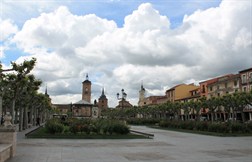Alcalá de Henares: the town of Cisneros, Cervantes and the Jesuits
 To stroll around the city of Alcalá de Henares means retracing the history of the ancient peoples who have dominated it: the Celts, Romans, Visigoths and Muslims. Among the legacy of this rich past, no doubt the remains stand out, which are still preserved, of the splendour of the ancient Roman city called Complutum (first century AD), on which the present Alcalá de Henares stands.
To stroll around the city of Alcalá de Henares means retracing the history of the ancient peoples who have dominated it: the Celts, Romans, Visigoths and Muslims. Among the legacy of this rich past, no doubt the remains stand out, which are still preserved, of the splendour of the ancient Roman city called Complutum (first century AD), on which the present Alcalá de Henares stands.
However, what most characterizes this city steeped in history – a UNESCO “World Heritage” – is its university tradition. In 1508, Cardinal Cisneros, the archbishop of Toledo and confessor of Queen Isabella the Catholic, conceived the creation of a new University at Alcalá, with a theology renewed by the spirit of humanism, distinct from other Spanish universities that followed the strict guidelines of medieval scholasticism. Since then, during the sixteenth and seventeenth centuries, the city of the river Henares came to establish itself as the Spanish city of reference for writers, philosophers and artists open to new spiritual and philosophical currents, both orthodox and heterodox, that circulated throughout Europe. For a long time the Spanish Inquisition sought to eliminate this center of excellence, to no avail.
 In addition to being a university city par excellence, Alcalá de Henares was the place of universal gestation for ideas and projects that marked the evolution of the history of Spain. It was here where Christopher Columbus was able to talk for the first time with the Catholic Monarchs in 1486 to present his proposed trip to India. But Alcalá is also the town where Miguel de Cervantes, the main author of the Spanish literature of the Baroque period was born. The quixotic spirit, known today throughout the world, can be perceived in many of the city streets and squares, and is particularly celebrated in the city festivities. Less known, but equally important, is another piece of the history of Alcalá, as one of the favourite places of Ignatius of Loyola, the founder of the Society of Jesus, who drew inspiration for the founding of the new religious Order in 1540 from the cultural environment of the city which was advanced for its time. Colleges, churches, statues and paintings related to the Baroque history of the Company are part of this route that runs through the streets of Alcalá de Henares.
In addition to being a university city par excellence, Alcalá de Henares was the place of universal gestation for ideas and projects that marked the evolution of the history of Spain. It was here where Christopher Columbus was able to talk for the first time with the Catholic Monarchs in 1486 to present his proposed trip to India. But Alcalá is also the town where Miguel de Cervantes, the main author of the Spanish literature of the Baroque period was born. The quixotic spirit, known today throughout the world, can be perceived in many of the city streets and squares, and is particularly celebrated in the city festivities. Less known, but equally important, is another piece of the history of Alcalá, as one of the favourite places of Ignatius of Loyola, the founder of the Society of Jesus, who drew inspiration for the founding of the new religious Order in 1540 from the cultural environment of the city which was advanced for its time. Colleges, churches, statues and paintings related to the Baroque history of the Company are part of this route that runs through the streets of Alcalá de Henares.
